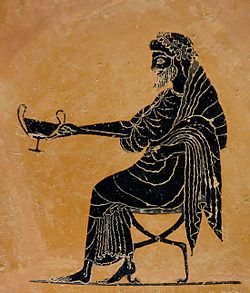
Back Psíax Catalan Psiax German Psiax Spanish Psiaks Finnish Psiax Italian Psjaks Polish Псиакс Russian Psiax SK Псіакс Ukrainian
Psiax (formerly the Menon Painter) | |
|---|---|
 Dionysos holding out a kantharos, black-figured plate by Psiax, ca. 520-500 BC, British Museum (B 589). | |
| Born | Psiax Before 525 BC Attica |
| Died | About 505 BC |
| Nationality | Athenian |
| Known for | Vase painting |
| Movement | Black-figure and Red-figure styles |

Psiax was an Attic vase painter of the transitional period between the black-figure and red-figure styles. His works date to circa 525 to 505 BC and comprise about 60 surviving vases, two of which bear his signature. Initially he was allocated the name "Menon Painter" by John Beazley. Only later was it realised that the artist was identical with the painters signing as "Psiax".
Psiax collaborated with the potters Hilinos, Menon, Andokides and Nikosthenes. While he started as a painter in the black-figure technique, he played a major role in the early development of red-figure, which was invented in the workshop of Andokides. The black-figure Antimenes Painter, working for the same workshop, was stylistically close to Psiax; Beazley described the two as "brothers". Perhaps unsurprisingly, considering his chronological position, Psiax was a master of bilingual vase painting. Formerly called the Menon Painter, after the potter’s signature on a red-figure amphora (Philadelphia, U. PA, Mus., 5349), he signed two red-figure alabastra as painter, both of which bear the signature of the potter Hilinos [Karlsruhe, Bad. Landesmus., 242 (B 120) and Odessa, A. Mus.]. Psiax also knew the white ground technique, as well as coral red pottery techniques.[1]
His signature is only known from two red-figure alabastra at Karlsruhe and Odessa, both also signed by the potter Hilinos. Three of the vases by him are signed by the potter Andokides. The fact that he painted kyathoi and used the Six's technique indicates that he also collaborated with Nikosthenes. In his early phase, Epiktetos imitated Psiax. The Pioneers Euphronios and Phintias were taught by Psiax.
Psiax mostly painted smaller vessels, appropriate to his fine painting style. Nevertheless, larger vases by him are also known, such as amphorae, hydriai and calyx kraters. On those, too, his figures are not so much powerful and lively but rather dignified and restrained. Although he experimented with the possibilities offered by the new technique (perspective), he concentrated more on the fine detail and decorative effect typical of Late Archaic art. He did not limit his activity to black-figure or red-figure but also experimented with black figures on white or coral-red ground and with the Six Technique.
His choice of subjects is conventional; arguably with a preference for scenes with horses and archers.
- ^ The Getty Museum - Biography of Psiax Archived 2012-02-06 at the Wayback Machine A vase-painter working in Athens in the late 500s B.C., Psiax is known from his signature on several surviving vases. A versatile painter, Psiax worked in every pottery technique in use at that time: black-figure, red-figure, white-ground, coral red, and Six's technique. He decorated the complete range of Greek vase shapes, both large and small, favoring Dionysiac scenes and the myths of Herakles. Most importantly, Psiax was an innovator. Two of his vases were signed by the potter Andokides, showing that Psiax worked in the shop where the red-figure technique was probably invented. He is also the first vase-painter interested in showing the human body in complex poses, a trait subsequently developed by the so-called Pioneers, at least one of whom, Euphronios, appears to have been Psiax's pupil.